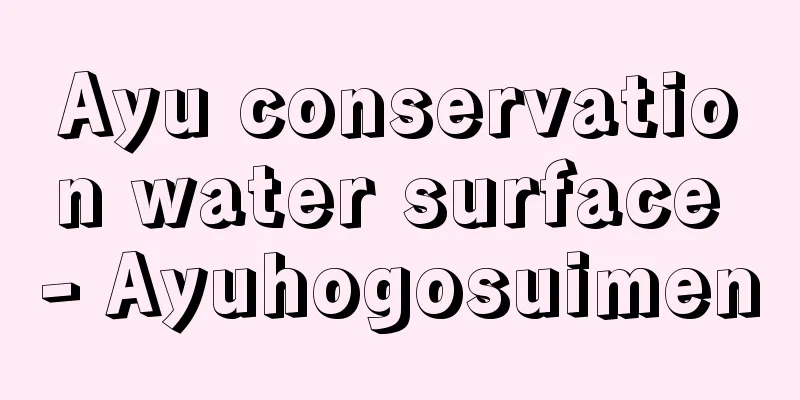Tokonoma

|
It is a place for appreciating paintings and flower arrangements on the walls of a tatami room. The floor is raised one level, a hanging scroll is hung on the front wall, and vases and ornaments are displayed on the floor. Historically, it started with hanging a Buddhist painting on the wall and placing a low table in front of it, on which were arranged a set of three or five pieces of furniture (one incense burner, one pair of vases, and one pair of candlesticks). Later, during the Song and Yuan dynasties, this style came to be used for appreciating paintings, and when the location was fixed and the alcove was built-in, it began to protrude from the wall as a recess. This style of alcove is called an oshiita or oshiita doko. Oshiita floors were used in early Shoin-zukuri rooms and in formal, formal Shoin-zukuri rooms; they are about 1 to 2 shaku deep, with a single thick plank of zelkova for the floor, straight-grained cypress for the hangings and alcove pillars, and it is common for sliding screen paintings to be painted on the surrounding attached walls. In the homes of the upper classes during the Muromachi period, a corner of a room was used as a place to sit or sleep, with a raised floor (yuka) of about 1 to 3 tatami mats, and was called a toko (toko). In such places, an oshiita toko (pressed floor) was often installed. In such places, decorations were sometimes placed not only on the oshiita toko but also on the tatami-laid toko (yuka), and as the size of small tea rooms with toko (toko) gradually decreased and narrower tea rooms of four and a half tatami mats or less were built, the toko (toko) and the oshiita toko were sometimes integrated, and it is thought that this led to the creation of the tatami-laid toko (toko), where hanging scrolls could be displayed and flowers arranged, just like the oshiita toko. From the history of their creation, the depth of a tatami-laid toko was usually half a ken (gen), the width of a tatami mat, and they were often made to protrude into the room. Records show examples of the Muromachi period's oshiita toko, in which the host and guest sat facing each other with the tokonoma to one side and admired the tokonoma decorations, but in the early modern period, in samurai homes, the host began to sit with his back to the tokonoma, and the meaning of the tokonoma changed. The tokonoma was originally created as a standalone, but it was combined with the staggered shelves, attached shoin, and chodai-gamae, which were created around the same time as zashiki decorations, tokonoma to form zashiki kazari. The tokonoma is the central element of zashiki kazari, with the staggered shelves placed beside it, and by 1600 (Keicho 5), a standard format had been established for the positions of the tsukeshoin and chodai-gamae. After that, as sukiya-style shoin became more widespread, zashiki kazari often omitted some elements, but in any case, the tokonoma is usually created as the most basic element and the central one. In shoin-zukuri, a press-on floor is the norm for the tokonoma, but as sukiya-style shoins became more widespread, interesting pillars of various shapes, including logs, began to be used for the tokonoma pillars. In standard shoin-zukuri, the hanging wall that secures the bottom of the small wall hanging from the ceiling above the tokonoma was also made of straight-grained cypress, but in sukiya-style shoins, natural logs, wood grain, and materials with unusual colors have become popular. In tokonoma alcoves with tatami mats, a tokogamachi is used for the front edge of the tatami mats, but in standard shoin-zukuri, a lacquered frame is usually used. In sukiya-style shoins, the tokogamachi is usually made of unusual materials and is a design that is elaborate. The walls surrounding the tokonoma are made of either clad walls or earthen walls to match the walls of the room in which the tokonoma is located, but normally, a press-on floor is clad walls, and the tokonoma in a sukiya-style shoin is made of earthen walls. As sukiya-style shoin (traditional Japanese study) buildings became more widespread, various modifications were made to the tokonoma alcove. Representative examples are the hanging tokonoma, which has no raised tatami floor or boards, but only short alcove pillars hanging down from the lowered wall and ceiling, and the Oribe tokonoma, which has boards simply inserted into the upper part of the wall. Even in the case of a standardized tokonoma structure, such as a oshiita-doko (push-board floor), each carpenter had their own wood divisions for the dimensions and positioning of the floorboards and the hanging scroll. There are many different tokonoma used in sukiya-style shoin (study rooms), but several styles are shown in the Hinagata book. [Hirai Sei] "Tokonoma" by Hirotaro Ota (Iwanami Shinsho) ©Minoru Sugai Names of the various parts of the tokonoma alcove ©Minoru Sugai Main types of tokonoma [Top] The origin of the tokonoma is a table (maedasu) placed in front of a Buddhist painting hanging on the wall. Sangusoku (incense burner, flower vase, candlestick) were placed on the table. [Bottom] Eventually the table became a built-in tokonoma (oshiita). This can be seen in a later addition to the "Moki Ekotoba." "Moki Ekotoba" (part) Copy held by the National Diet Library "> Tokonoma alcove as seen in the "Mokie-shi" Source: Shogakukan Encyclopedia Nipponica About Encyclopedia Nipponica Information | Legend |
|
座敷の壁面に設けられた絵画やいけ花を観賞するための場所で、床(ゆか)を一段高くし、正面の壁に掛軸を掛け、床の上に花瓶・置物などを飾る。 歴史的には、壁に仏画を掛け前に低い卓を置いて、その上に香炉・花瓶・燭台(しょくだい)から構成された三具足(みつぐそく)あるいは五具足(ごぐそく)(1個の香炉、1対の花瓶、1対の燭台)を並べたのが初めで、のちに、宋(そう)・元(げん)画を観賞する形式となり、その場所が固定化して造り付けになったときに、凹所として壁から部屋の外へ張り出す形式ができた。この形式の床の間は、押板(おしいた)あるいは押板床(どこ)とよばれている。押板床は初期の書院造の座敷や格式の高い正規の書院造の座敷に用いられ、奥行が1~2尺ほどで床(ゆか)板に厚いケヤキの一枚板を用い、落掛(おとしがけ)や床柱(とこばしら)をヒノキの柾目(まさめ)材とし、周囲の張付壁には障壁画を描くのが普通である。 室町時代の上層階級の住宅では、座ったり寝るための場所として居室の隅の床(ゆか)を1~3畳分ほど一段高くして、床(とこ)とよんでいた。このような場所には押板床が設けられることが多かった。そのようなところでは、押板床の上だけでなく畳敷きの床(ゆか)の上にも飾ることがあり、また、床(とこ)のある座敷をしだいに縮小して四畳半以下の狭い茶室がつくられていく過程で床(とこ)と押板床が一体化されることもあって、押板床と同様に掛軸を飾り花をいける畳敷きの床の間ができあがったと考えられる。成立の経過から、畳敷きの床の間の奥行は畳の幅である半間(げん)が普通で、部屋の中へ張り出してつくられることが多かった。 室町時代の押板床は、その前に主人と客が床の間を側面にして相対して座り、床の間の飾りを観賞する例が記録に現れるが、近世になると武家住宅では主人が床の間を背にして座るようになって、床の間の意味が変わってくる。床の間は成立の過程では単独であったが、座敷の装飾として同じころ成立した違い棚・付書院(つけしょいん)・帳台構(ちょうだいがまえ)と組み合わされて座敷飾りを形成した。床の間は座敷飾りの中心的な要素で、そのわきに違い棚が配置され、1600年(慶長5)ころには付書院・帳台構の位置にも標準的な形式ができあがった。それ以後、数寄屋(すきや)風の書院が広まるにつれて座敷飾りはいくつかの要素を省略して使うことが多くなるが、いずれの場合にも床の間はもっとも基本的な要素として中心的につくられるのが普通である。 床の間は、書院造では押板床が普通であるが、数寄屋風の書院が広まるとともに床柱には丸太をはじめさまざまな姿のおもしろい柱が使われるようになる。床の間の上の天井から下がる小壁(こかべ)の下端を留める落掛も、正規の書院造では柾目のヒノキが使われていたが、数寄屋風の書院では自然の丸太や木目(もくめ)や色の変わった材が喜ばれるようになった。畳敷きの床の間では畳の前縁に床框(とこがまち)を用いるが、正規の書院造では通常黒く漆を塗った塗り框としている。数寄屋風の書院では床框にも変わった材を用いるなど意匠に凝るのが普通である。床の間の周囲の壁は、床の間が設けられている座敷の壁にあわせて張付壁または土壁とするが、通常、押板床は張付壁、数寄屋風書院の床の間は土壁とする。 数寄屋風の書院が広まると、床の間にはいろいろな変形ができた。一段上がった畳敷きも板も設けず、下がり壁と天井から下がり短く切られた床柱だけの釣り床や、壁の上部に板を入れただけの織部床(おりべどこ)はその代表例である。 床の間の造りは押板床のように形式化されたものでも、大工家ごとに落掛や床の板の寸法・位置などに木割があった。数寄屋風の書院に使われる床の間はさまざまであるが、雛形(ひながた)本にいくつかの形式が示されている。 [平井 聖] 『太田博太郎著『床の間』(岩波新書)』 ©須貝 稔"> 床の間の各部名称 ©須貝 稔"> 床の間のおもな種類 〔上〕壁に掛けた仏画の前に置いた卓(前机)が床の間の起源である。卓の上には三具足(香炉、花瓶、燭台)を置いた。〔下〕やがて卓が造り付けの床(押板)になる。後年の『慕帰絵詞』補加部分にそれをみることができる。『慕帰絵詞』(部分) 写国立国会図書館所蔵"> 『慕帰絵詞』にみる床の間 出典 小学館 日本大百科全書(ニッポニカ)日本大百科全書(ニッポニカ)について 情報 | 凡例 |
>>: Tokonoushin (English spelling)
Recommend
Artemis - Artemis
A virgin goddess in Greek mythology. Daughter of ...
Kyo Tsuneto - Tsunetokyo
Legal philosopher. Born December 3, 1888 in Matsu...
Ezo White Butterfly - Ezo White Butterfly
...In Hokkaido, it occurs twice a year (May and J...
Sloan, Alfred P., Jr.
Born: May 23, 1875 in New Haven, Connecticut [Died...
Radical Royalists - Radical Royalists
…He participated in the Pillnitz Declaration in 1...
immunological paralysis
…However, (2) and (3) are phenomena seen in speci...
Fukuyama Domain
The Tokugawa Fudai Domain ruled over the Fukuyama...
Calorie - Calorie (English spelling)
In physics, the joule is used as the unit of ener...
Amarushin - Amarushin
...Later, his son (or brother) Ur-Nammu gained in...
Ensemble (music) - Ensemble
In French, it means "together." Original...
Frost heave
…The latter, also known as freeze disturbance, is...
Promix
… Cellulose diacetate with an acetylation degree ...
Artemisia annua (English spelling) Artemisia annua
…[Hiroshi Aramata]. … *Some of the terminology th...
Mossi Kingdom - Mossi Kingdom
The kingdom of the Mossi people was probably forme...
Emulsion chamber
A device that detects high-energy photons by alter...









